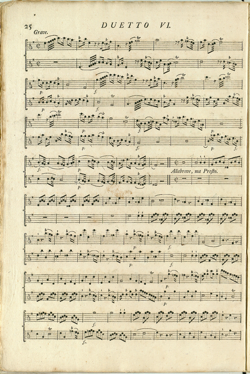J. J.Quantz:
Sei Duetti (Berlin, 1759)

The Sei Duetti a due flauti traversi (six duets for two transverse flutes) published in Berlin in 1759 are historically significant and engaging compositions that deserve to be heard by a wider audience. They also provide excellent material to work with when studying Quantz’s Versuch. Published seven years after the Versuch, it is clear that Quantz considered the edition, including its lengthy Preface, to be a supplement to the Versuch. For this reason Barthold Kuijken includes a facsimile of the Preface in the facsimile edition of the treatise published by Breitkopf & Härtel in 1983.
Quantz does not discuss duets in any depth in the Versuch, but he does stress the advantages of practicing ‘well-elaborated’ (i.e. contrapuntal) duets. As Edward R. Reilly has noted, in the Preface to the Sei Duetti ‘the various characteristics of “good” duets are outlined along exactly the same lines found in Quantz’s descriptions of musical forms in the Versuch. … The passage might be inserted unaltered between the discussion of trios … and that of solos.’
Reilly includes an English translation of the Preface in ‘Further Musical Examples for Quantz’s Versuch’ (JAMS, 1964) and makes some interesting observations about the Sei Duetti:
Stylistically, the six duets … provide excellent examples of the composer’s intermediate position between the Baroque and Classica eras. They afford the performer and scholar an opportunity to test the author’s precepts in an appropriate context. As a composer Quantz certainly cannot be classed among the great, but he does display a high level of craftsmanship, and his works frequently come alive in actual performance in a way one would hardly expect from simply analyzing the printed page. They clearly illustrate the qualities and defects of much mid-18th-century music, and how dependent such music is on certain basic elements of performance. Re-created with the clarity of phrasing, dynamic variety, and in fast movements the briskness which Quantz demands, the duets become elegant, light, and tender. Performed too slowly and clumsily, they are merely tedious.
Having performed these duets many times in concerts and for this recording, we now think the music is probably better than Reilly is suggesting. He is correct that they come alive in actual performance and Quantz’s ideas on performance practice make a big difference. The slow movements in particular are often very expressive. Reading the Versuch confirms Quantz’s strong expressive intentions in performance.
We have been gratified by the positive responses from our audiences. These types of duets are quite different to other forms of Baroque chamber music and fit in well with the idea of ‘elegant conversation’. Quantz says that duets have ‘certain merits peculiar to themselves’ and describes them as ‘an elaborate music written in contrapuntal or imitative style.’ There are many beauties to be discovered when listened to attentively.
Instrumentation
While the title page of the Sei Duetti states they are for two flutes, in the Preface Quantz says they can be performed on other instruments such as on a flute and a muted violin, as well as other combinations of matched instruments (two violins, two oboes etc). He goes on to say:
‘In general, duets as well as trios produce a better and more intelligible effect on two instruments of different types than upon instruments of the same kind.’
So the combination of flute and muted violin seems to be a preferred option.

A PDF scan of the first edition of Quantz’s Sei Duetti
is availabe for download from IMSLP [9.1MB]
(International Music Score Library Project)
